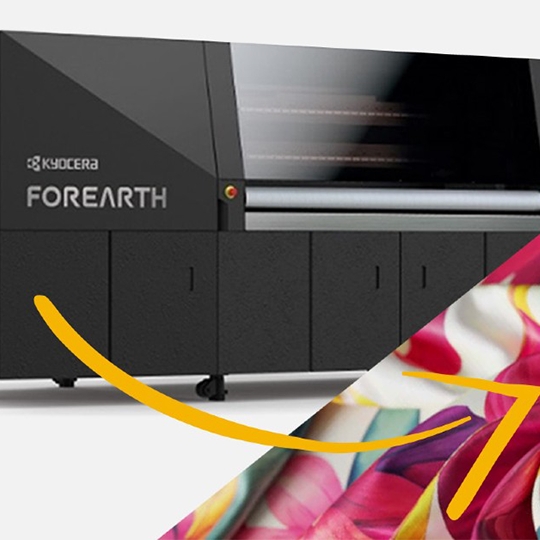Kyocera’s new inkjet digital textile printer, FOREARTH, busts preconceptions in a way that could free fashion from the environmental and economic burdens of wasted water and fabric.
Around a fifth of the world’s water pollution and a tenth of its carbon emissions come from textiles. “Washing water discharges 500,000 tonnes of microfibre, the equivalent of 50 billion plastic bottles, into the ocean every year,” explains Sho Taniguchi, deputy general manager of the inkjet digital printing (IDP) business development division at Kyocera. “When I see this figure, I’m shocked, actually.”
The urgency of dealing with this issue is heightened by a trend towards greater consumption and disposal of clothing. For example, research has found that while people bought 60% more garments in 2014 than they did in 2000, they kept them only half as long. But hope could be at hand: Mr Taniguchi is in charge of sales and marketing for a new initiative, called FOREARTH, which could significantly change the textile industry and its impact on the environment.
Digital textile printing on fabric is already big business. Even without its own fabric printer, in 2022 Kyocera’s inkjet printheads for textiles had a 52% market share by digitally printed area through their presence in equipment from other manufacturers, accounting for 1.6bn square metres of fabric printed.
Kyocera has developed FOREARTH to reduce environmental impacts such as the large amount of water pollution and carbon emissions caused by printing.
Settling the problem of waste in the textile industry
Kyocera is stepping into an environment where top fashion and textile brands have set sustainability visions and targets as the world reaches for net-zero CO2 emissions by 2050.
In August 2019 at the G7 summit in Biarritz, France, 32 companies joined the Fashion Pact agreement proposed by Kering Group chairman François-Henri Pinault, pledging to pursue goals on climate change, biodiversity and ocean protection. Meanwhile, Mr Taniguchi highlights, national governments are setting up robust laws to force change in the industry. In France, for example, a 2020 law to promote the circular economy mandates that most unsold clothing, shoes, cosmetics, books and home appliances should be donated or recycled.
These commitments and regulations are driving the industry towards both digitisation and waste reduction. FOREARTH tackles these imperatives simultaneously. “We brought all the top engineers for each speciality into one team and decided to build the most sustainable textile printer, to contribute to society and the fashion industry,” says Mr Taniguchi. “We’d like to provide a solution to settle the problem.”
Why inkjet printing is a way forward
Customers familiar with traditional screen-printing have been surprised to learn that inkjet printers can supply the fashion industry’s needs.
It has been a challenge to overcome the scepticism of industry leaders who doubted that inkjets using pigment-based ink could achieve high-definition, colourfast results without making the fabric stiff. The prevailing belief was that only dye-based inks, where the colour is completely dissolved in water, can do the job.
FOREARTH tackles this issue by having the printhead discharge a pre-treatment liquid and finishing agent along with the pigment. Mr Taniguchi enthusiastically shows samples of the results—full-colour printed fabrics with intricate designs, vibrant colour and the softness that high-end fashion brands demand.
With those qualities demonstrated, the industry can explore what environmental problems FOREARTH might solve, especially by conserving water. Traditional screen-printing uses around 150 litres of water to print 1 kilogram of fabric in a multi-step process that includes making and washing screens, mixing colours, and steaming and washing the fabric after printing.
By contrast, FOREARTH’s digital textile printing alternative uses just 0.02L of water to print 1kg of fabric. This is a reduction of more than 99.98%. The process has only two steps: print the fabric and then dry it.
Expanding creative possibilities
FOREARTH offers the remarkable ability to print on different fabric types, eliminating the need for separate production lines using different inks for cotton, polyester and silk. This increases factory efficiency by reducing the space required. Traditional printing methods have production lines 35-100 metres long for printing, steaming, washing and drying. A FOREARTH-based line could be just 10 metres long.
This massive footprint reduction could revolutionise the logistics of the fashion industry. Producers will be able to switch from offshore production to make fabrics much closer to consumers, saving costs and emissions from transport while speeding delivery. And as regulations like the French circular economy law emphasise waste reduction which Kyocera has long championed fashion businesses are increasingly keen to keep the amount of fabric they print, and the number of garments they make, tightly aligned with demand.
This has been an elusive goal: traditional methods compelled companies to commit to a print run of at least 2,000-5,000 metres, Mr Taniguchi says. Samples had to be a minimum of 2-3 metres long. FOREARTH introduces a sample print mode with A4 as the minimum size. Full print runs can be only 10 metres and still be economically viable.
Improved logistics and shorter print runs will make the industry more nimble. “The market trend is towards more personalisation,” says Mr Taniguchi. “It requires not more volume but greater variety and speed.”
Working together towards the future of digital textile printing
A customer who mainly prints on viscose and cotton might be thinking about building a new factory to print on nylon, but with FOREARTH they will not have to. Or the solution could be the perfect fit for a high-fashion brand whose sustainability goals have them wanting to clamp down on water use. “We have a solution here,” Mr Taniguchi says.
Nine-tenths of the industry is still analogue, he points out, and this is a major reason that pollution persists. “Digitisation is still only 11%,” which means there is a huge market share left to capture—requiring that multiple firms work on developing solutions and selling them to textile-makers. “No one is a competitor,” he says. “We would like to work together to decrease the environmental impact of textiles by increasing the penetration of digital printing solutions. We call the model SDX— unstainable digital transformation.”
95.7% of executives in top business hubs across the globe expect green skills to become the most important skill in the next five years. Is your business ready to be part of the movement towards this sustainable future? Download the new Economist Impact report to learn how companies across major cities are cultivating green skills to gain a competitive edge and build a better tomorrow.
This article was produced by EI Studios in collaboration with Kyocera
Document Solutions. Find out more.




